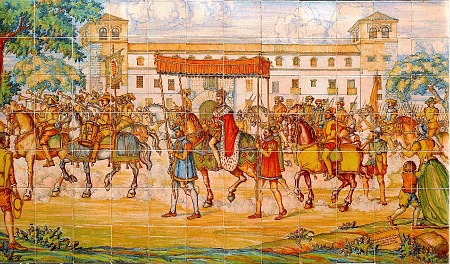The Biography
of Luis de Narváez
ca. 1500-1555
A Noted Vihuelist
Luis de Narváez's birthplace sometime around the year 1500 was Granada, Spain. Highly regarded as a composer and vihuelist in his lifetime, today he is known for a published collection of polyphonic vihuela music Los seys libros del delphín which includes the earliest known variation sets.
He first appears in 1526 in the household of Francisco de los Cobos y Molina, the secretary of state and comendador for the kingdom of Castile under Charles V the king of Spain. Narváez lived in Valladolid, the then capital of Spain, in the employment of this personage who was famously also a patron of the arts. It was here in 1538 that the composer published Los seys libros del delphín which he dedicated to his patron. By 1548 he was employed as a musician in the royal chapel of Felipe, regent of Spain (later Philip II of Spain) along with the famous keyboard composer Antonio de Cabezón, Narváez also taught music to the chapel's choristers and conducted the choir. He accompanied the royal entourage on many journeys and his last historical reference is that he resided in the Low Countries during the winter of 1549.

Transciptions from lute music
This Spanish Maestro is known as the earliest composer for the vihuela to adapt Italian style lute music for his instrument. As a vihuelist he was highly regarded in his lifetime, particularly his improvisatory skills which included an ability to improvise a tetrachord (4 part) music based on another tetrachord piece which he had never seen before. He also was devoted to polyphonic vocal music.performed by
Jesús Cornejo
The six-volume collection for vihuela Los seys libros del delphín (Valladolid, 1538) is Narváez's most important surviving music. The collection is dedicated to his then patron Francisco de los Cobos. The tablature notation employed for the collection is a modified version of Italian lute tablature. The first two volumes feature fourteen polyphonic fantasias modelled after the Italian style. Occasionally short motifs with identical left-hand fingering is used, this probably reflecting techniques he used for improvisation. The music is reminiscent of the work of the Italian lutenist Francesco da Milano, whose works Narváez collected.

one of Narváez's earlier patrons
- selections from masses by Josquin des Prez
- the famous song Mille Regretz by the same composer, which is subtitled "La canción del Emperador" (The song of the Emperor) perhaps suggesting that this was a favourite of Charles V.
- two songs by Nicolas Gombert (one wrongly attributed - it is by Jean Courtois)
Rob
Volumes four to six are of a mixed content and importantly feature the earliest known variation sets, the six diferencias or variations. Narváez's models include both sacred (volume four only) and secular melodies, and the music stands out by virtue of an extensive range of different techniques. Besides the variations on melody, volume six also features the pieces Guardame las vacas and Conde claros - which are both sets of variations on ostinato harmonies. The remaining music comprises villancicos, romances, and a Baxa de contrapunto.
| Find your favourite Luis de Narváez Sheetmusic at this page! |
|---|
Other Renaissance composers :
|
|
Antonio de Cabezón's Diferencias sobre el canto del caballero |
Manuel Maria Ponce's Variazioni |






